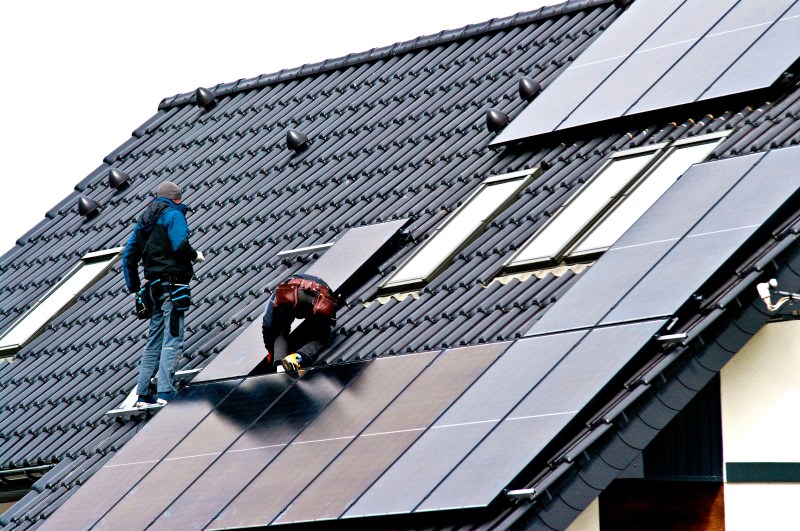

Ask Hackaday: How Can You Store Energy At Home?
source link: https://hackaday.com/2022/08/16/ask-hackaday-how-can-you-store-energy-at-home/
Go to the source link to view the article. You can view the picture content, updated content and better typesetting reading experience. If the link is broken, please click the button below to view the snapshot at that time.
Ask Hackaday: How Can You Store Energy At Home?

Amidst the discussions about grid-level energy storage solutions, it is often easy to forget that energy storage can be done on the level of a single house or building as well. The advantages here are that no grid management is needed, with the storage (electrical, thermal, etc.) absorbing the energy as it becomes available, and discharging it when requested. This simplifies the scale of the problem and thus the associated costs significantly.
Perhaps the most common examples of such systems are solar thermal collectors with an associated hot water storage tank, and of course batteries. More recently, the idea of using a battery electric vehicle (BEV, ‘electric car’) as part of a home storage solution is also gaining traction, especially for emergencies where the grid connection has failed due to a storm or similar emergencies. But all-in-all, we don’t see many options for home-level energy storage.
The Grid Storage Problem
Bath County Pumped Storage Station (Credit: CHA)
A while back, we looked at the motivations behind grid-level storage, including current and future technologies. The increasing focus on long-duration storage is driven by the increasing amount of intermittent, non-dispatchable energy sources on the grid, including PV solar and wind turbines. As these produce highly fluctuating levels of energy, storing excess power for later use is useful and arguably essential.
Unfortunately, the conclusion there is that grid-level storage at a scale sufficient to store and time-shift such amounts of energy on the level of an entire nation is not feasible. Of note here is that virtually all of newly produced battery capacity today and for the future will go into BEVs, which is where the idea of Vehicle2Grid (V2G) was pitched as a potential grid-level storage, This we looked at too, and found it wanting from an economical and practical perspective.
Much of the problem comes down to the highly fluctuating amounts of energy being supplied, and the increasing mismatch between supply and demand the more intermittent sources are added to the grid. Having e.g. roof-based solar panels that feed into the grid contributes to this problem, causing increased local power surges whenever there’s a lot of sun in an area, even as feed-in tariffs are being cut and even abolished in more areas. This leads to both utility providers and home owners facing increased costs and decreased (financial) benefits.
All of this only concerns electrical power, of course. Homes, offices and the industry also require heating, hot water and e.g. steam for industrial processes. Here local options would seem to make significant sense where e.g. district heating is not an option. With the use of existing solutions such as heat pumps and hot water storage tanks, it would seem that here at least straightforward solutions exist.
Energy Sources
While it is possible to also charge a battery and heat water in a hot water storage tank from the local grid for later consumption (e.g. with off-peak rates), another energy source that is readily available is the Sun. Adding solar thermal collectors on the roof as part of a solar water heating solution can be cost-effective, depending on the solar irradiance levels (power per unit area). The effectiveness is here mostly determined by the payback period, which can range between in the order of 4 years to closer to 20 years.
An important consideration here is too whether anti-frost features are required. While a purely passive and thus rather cheap system would be fine in a warm climate, if temperatures drop below 0°C during winters, it’s essential that measures are taken. This can include adding anti-freeze to the water in the system, in which case a more expensive closed-loop system is required as well.
In addition to the heat from solar irradiation, the energy from the Sun can also be converted into electricity using photovoltaic (PV) solar panels. Currently, most roof-based PV solar installations do not have local storage, and self-consumption is not considered, with the prevailing business model being that of selling the produced power to the local utility.
Some locations may also have space for other energy sources, like a (small) wind turbine, but solar thermal collectors and PV solar panels are likely to be the primary sources of energy when other sources (like hydro) are not available.
Storage Solutions
Hot water storage setup using solar thermal collectors as well as resistive heating using (PV) electricity.
As mentioned, heating water is a very common way of capturing and storing solar thermal energy. Many houses have a hot water storage tank in which a supply of water is kept at a specific temperature for immediate use. The main difference is in how the water in these tanks is heated. Often fossil fuels like mineral oil or natural gas are used, while in other areas electrical (resistive) heating is more common. When used in a context where solar thermal collectors and/or PV solar panels are available, the water can also be heated purely by these sources.
The advantage of this system is that it provides a potentially cost-effective source of hot water, which tends to be one of the more energy-intensive uses. It also provides an effective use of the electricity from PV solar panels when it is not used to charge batteries.
This leads to the other obvious storage solution in the form of large battery storage, such as Tesla’s Powerwall and similar offerings by competitors. Recently, Broughton et al. (2021) detailed the economics of battery storage for residential solar customers in Southern California.
In California the feed-in tariff has been dropping for years now, with the current NEM 3.0 program reducing the financial incentive to produce PV power for the grid. Not surprisingly, the introduction of Time-of-Use (TOU) with the NEM 2.0 program, saw the number of battery storage installations by home owners already increase significantly.
The conclusion by Broughton et al. was however that with the payback period when having a single Tesla Powerwall 2 system installed, along with a PV solar installation, was too long for this to make any financial sense. Where having battery storage like this installed does make sense, is when the grid power is unreliable, as is increasingly the case in California.
This then makes the argument to instead charge a BEV with the power from a (roof-mounted) PV solar installation, and have a charger that is capable of inverting the energy flow so that the BEV can act as an emergency battery to power the house. Even so, the economics of whole-house battery storage do not seem to be quite there yet when one lives in an area where utility-provided power is an option.
Wrapping Up
The general theme here when looking through the recent studies on home energy storage and related fields seems to be that storing energy in large quantities is only likely to be economical when it concerns heating up water in a hot water storage tank. The payback period here can be rather minimal when the conditions are right, and even adding a PV solar panel for resistive heating of the water may make financial sense depending on local factors.
This is also the case with battery storage solutions. Considering that the main cost of a BEV is due to the battery pack, it isn’t too surprising that something like a Tesla Powerwall costs about the same as a BEV. Here one could run the numbers on whether perhaps running a large array of (sealed) lead-acid batteries might nudge the numbers closer to financial sense.
Either way, the topic of home energy storage is not one which is likely to go away any time soon. Even if one’s intention isn’t to go off the grid, there are many other incentives that would lead one to look at the options. Whether it’s cost-savings, or having a backup option when there are rolling blackouts as we have seen around the world the past years, there are many reasons to take a look at the available storage options. But we simply didn’t come up with much.
What are your experiences and thoughts in this regard? Since the Hackaday community tends to have a lot of tinkerers, no doubt some of you have implemented any of these generating and storage systems, or have at least looked at the cost picture. If you have a whole-house battery system and/or solar-powered hot water system, how is it working for you?
Recommend
About Joyk
Aggregate valuable and interesting links.
Joyk means Joy of geeK

